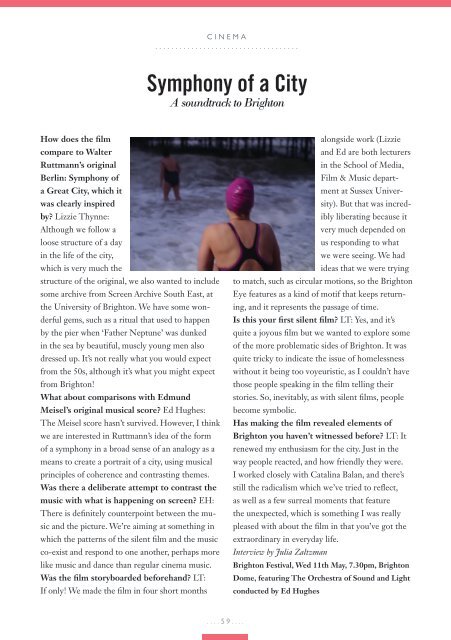Create successful ePaper yourself
Turn your PDF publications into a flip-book with our unique Google optimized e-Paper software.
CINEMA<br />
....................................<br />
Symphony of a City<br />
A soundtrack to <strong>Brighton</strong><br />
How does the film<br />
compare to Walter<br />
Ruttmann’s original<br />
Berlin: Symphony of<br />
a Great City, which it<br />
was clearly inspired<br />
by? Lizzie Thynne:<br />
Although we follow a<br />
loose structure of a day<br />
in the life of the city,<br />
which is very much the<br />
structure of the original, we also wanted to include<br />
some archive from Screen Archive South East, at<br />
the University of <strong>Brighton</strong>. We have some wonderful<br />
gems, such as a ritual that used to happen<br />
by the pier when ‘Father Neptune’ was dunked<br />
in the sea by beautiful, muscly young men also<br />
dressed up. It’s not really what you would expect<br />
from the 50s, although it’s what you might expect<br />
from <strong>Brighton</strong>!<br />
What about comparisons with Edmund<br />
Meisel’s original musical score? Ed Hughes:<br />
The Meisel score hasn’t survived. However, I think<br />
we are interested in Ruttmann’s idea of the form<br />
of a symphony in a broad sense of an analogy as a<br />
means to create a portrait of a city, using musical<br />
principles of coherence and contrasting themes.<br />
Was there a deliberate attempt to contrast the<br />
music with what is happening on screen? EH:<br />
There is definitely counterpoint between the music<br />
and the picture. We’re aiming at something in<br />
which the patterns of the silent film and the music<br />
co-exist and respond to one another, perhaps more<br />
like music and dance than regular cinema music.<br />
Was the film storyboarded beforehand? LT:<br />
If only! We made the film in four short months<br />
alongside work (Lizzie<br />
and Ed are both lecturers<br />
in the School of Media,<br />
Film & Music department<br />
at Sussex University).<br />
But that was incredibly<br />
liberating because it<br />
very much depended on<br />
us responding to what<br />
we were seeing. We had<br />
ideas that we were trying<br />
to match, such as circular motions, so the <strong>Brighton</strong><br />
Eye features as a kind of motif that keeps returning,<br />
and it represents the passage of time.<br />
Is this your first silent film? LT: Yes, and it’s<br />
quite a joyous film but we wanted to explore some<br />
of the more problematic sides of <strong>Brighton</strong>. It was<br />
quite tricky to indicate the issue of homelessness<br />
without it being too voyeuristic, as I couldn’t have<br />
those people speaking in the film telling their<br />
stories. So, inevitably, as with silent films, people<br />
become symbolic.<br />
Has making the film revealed elements of<br />
<strong>Brighton</strong> you haven’t witnessed before? LT: It<br />
renewed my enthusiasm for the city. Just in the<br />
way people reacted, and how friendly they were.<br />
I worked closely with Catalina Balan, and there’s<br />
still the radicalism which we’ve tried to reflect,<br />
as well as a few surreal moments that feature<br />
the unexpected, which is something I was really<br />
pleased with about the film in that you’ve got the<br />
extraordinary in everyday life.<br />
Interview by Julia Zaltzman<br />
<strong>Brighton</strong> Festival, Wed 11th <strong>May</strong>, 7.30pm, <strong>Brighton</strong><br />
Dome, featuring The Orchestra of Sound and Light<br />
conducted by Ed Hughes<br />
....59....


















